This blog post is contributed by Mark Bentley, MIDAS Principal Investigator at the Space Research Institute (IWF) in Graz, Austria.
One of the big challenges in planning MIDAS operations is predicting the amount of dust that we collect during an exposure. Measuring the rate of dust grains flying past Rosetta and their size distribution is, of course, part of our science, but to plan our operations, we need to have some idea of what to expect beforehand! This is particularly complicated because with MIDAS, we are interested in measuring the smallest cometary dust particles, less than 1 µm (micrometre or millionth of a metre) in size, and ground-based telescope observations that are used to study dust remotely are almost blind to these sizes.
So with that in mind, we started our first exposure in mid-September, opening the shutter for about 4 days. MIDAS works by collecting dust grains on sticky targets that are then scanned at very high resolution using an atomic force microscope.
Initial calculations suggested that we might find one particle of around 1 µm in an 80×80 µm scan. The “before” and “after” images are shown in the panel below – as you can see, nothing jumps out, as most of the features seen in the after image were also there before we opened the shutter, meaning that they are background contamination (this is why we need to take a scan before!). If you look closely, you might even convince yourself that one or more particles have disappeared, but this is just a result of small offsets in the position of each pixel.
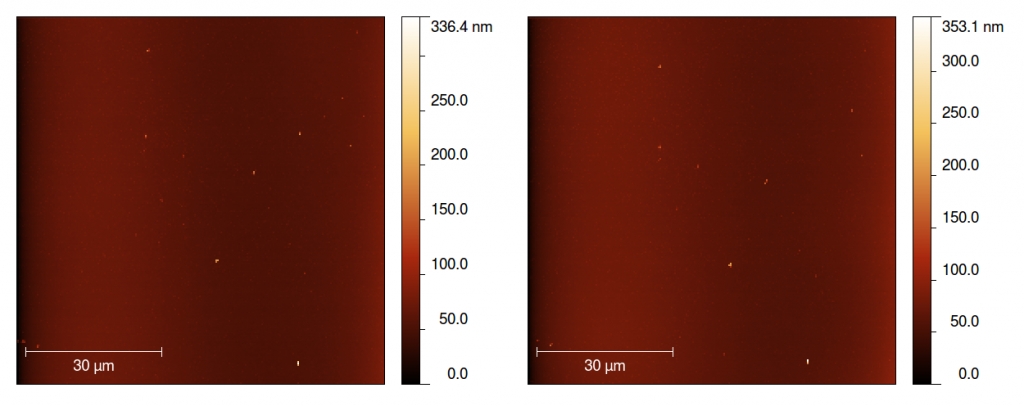
Images of the MIDAS target before (left) and after (right) exposure in September 2014. The image shows an 80×80 µm portion of the target (the full target measures 1.4 x 2.4 mm). An indication of size is provided, and the colour scale provides a measure of the third spatial dimension (height). Image courtesy of Mark Bentley.
During the following weeks, the same target was exposed and scanned several more times to search for particles. Again, we didn’t see anything obvious. Then, as you may recall, something special happened in mid-November: the Philae lander was deployed to the surface of comet 67P/C-G. Instruments on-board the orbiter had to be in a state where they would be safe regardless of what happened during the lander delivery and, for MIDAS, this meant opening the shutter and exposing the target once more from 9–14 November.
Immediately afterwards, we began yet another scan of the centre of the exposed target. Unfortunately, this scan aborted after several lines – this can happen for several reasons, for example if a temperature change on-board causes the microscope to lose contact with the surface. As a result, it took us a week or so to look back at this small section of a scan. When we did, however, we had a surprise:

Scan of the MIDAS target exposed in November 2014. The image shows an 80×80 µm portion of the target (the full target measures 1.4 x 2.4 mm). Image courtesy of Mark Bentley.
Although it doesn’t look like much, this is in fact our first cometary dust particle!
A few things to note. The bottom black part of the image is not real data – this was after the scan aborted. Similarly, the white horizontal stripes in the upper part of the image, mostly towards the right side, are not real. MIDAS works by rastering over the sample – in this case from left to right in lines, starting from the top. If the sharp tip of the atomic force microscope moves to the next position and immediately thinks that it has detects the surface … oops, we’ve hit a dust particle!
In this case, MIDAS plays it safe and moves the tip up and away from the particle. However, there’s a limit to this movement and if it can’t move up far enough to get above the particle, the current line is aborted and the tip is moved down to the start of the next one – this is what produced the white horizontal stripes. If the topography is too high even at the start of the new line making it impossible for MIDAS to retract any further, the whole scan aborts.
Both of these things happened here, because the particle was much larger than expected!
If we zoom in on the “feature” in the first few lines, we can begin to get some idea about what was collected: the complex pattern visible in the upper right part of the image is, in fact, our first dust particle.

Above and below, two zooms of the MIDAS target exposed in November 2014. An indication of size is provided, and the colour scale provides a measure of the third spatial dimension (height). Images courtesy of Mark Bentley.
The first thing we see is that the particle is roughly 10 µm in size in the plane of the target, and slightly less in height. Interestingly, we expected to find many smaller particles before catching such a large one.
The next thing to note is that this dust particle appears to be complex in shape and not compact, suggestive of a “fluffy” aggregated grain.
To measure the full size of the grain and to answer more detailed questions, we will need to re-image it – knowing now that it is so large, we can optimise the scanning parameters to avoid hitting the particle from the sides and instead just tap it gently, something that MIDAS is designed to do.
This may not look like much, but it already tells us a lot about the dust environment of comet 67P/C-G and allows us to optimise our collection and scanning strategies. And don’t forget, it’s MIDAS’s first confirmed cometary dust particle – 20 years after the instrument was proposed, and after 10 years in flight! Watch this space for more details in the coming weeks.

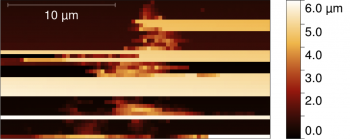
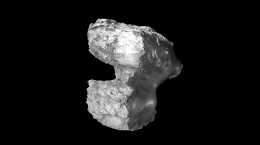
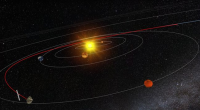
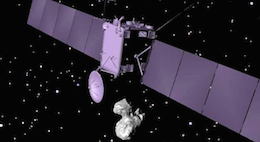

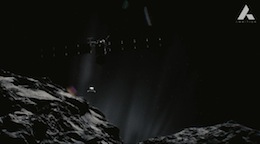
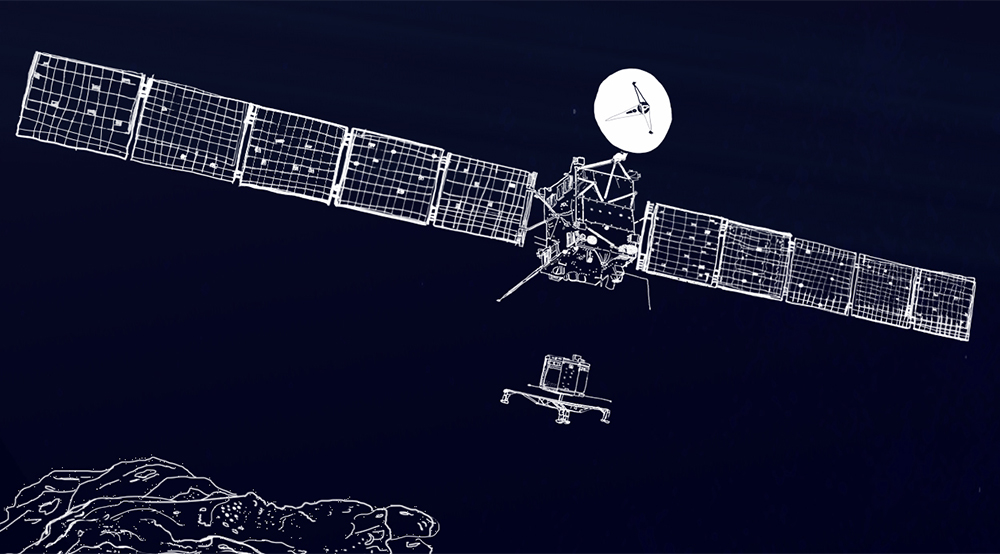
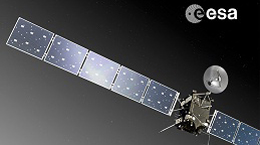
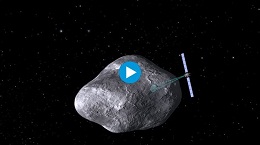
Discussion: 24 comments
Thank You so much Mark, his team and Claudia for getting this information posted so quickly. I watched the presentation from the AGU meeting. First of all an absolutely unbelievable piece of ambition to put an Atomic Force Microscope on a spacecraft, and to get it to almost work first time is amazing. In your talk there were better images of other “grains”. It is perhaps better to call them bits of fluff. They do appear to be incredibly fragile, held together by nothing but the physical interlocking of molecules, sintering and Van de Vaal’s forces would be my guess. Incredible stuff!!
Thanks! Yes, they do seem to be rather weak aggregates. This was not wholly unexpected, but it’s great to see – and we’re looking forward to getting better data in the coming weeks to confirm!
Very interesting description.
Do I understand well that the baseline method for scanning was contact AFM and not tapping?
In this case, I would like to understand the rationale behind, as it seems counter-intuitive to me for the observation of unknown surface defects.
MIDAS can operate in contact or in tapping mode – though we usually use tapping, and did above.
Why was the OSIRIS presentation not shown?
What makes them so special? Those images are worth lots of money, thats what. A total and utter disgrace. Its disrespectful to the ideals of the AGU, ESA and the rest of the Rosetta team.
This is not the first journey for Midas in space or in lab, but so far the most fuzzy i have seen. Sad story. Hope for improvement as Midas can see more then just the SIZE of a particle.
MIDAS was the first Atomic Force Microscope to be launched into space in 2004. We have a lot to learn about how to operate an AFM in this environment, and hopefully you’ll see lots of improvements over the next year!
Why in esa’s view is it a surprise to have a large particle?
Is it because the dust on the comet is supposed to be made from primordial dust that is much finer?
If this dust is not being collected, does it mean that the comet was not put togethether 5 billion years ago?
Can you give us a steer?
Most cometary dust that we have observed before has a distribution where there are more smaller grains than larger grains – but nobody has ever been this close to a comet before to sample the real distribution.
We expected many more smaller particles for every larger one, so it was a surprise after weeks of scanning to find only larger grains!
Hi Mark Bentley. So, this ‘grains’ are aerodynamically ‘teared’ segments from much bigger structures. [You need big surfaces to exert enough force to tear a ‘bond’].
Have the greatest scientific expectations from the MIDAS Team effort 🙂
Congratulations to the inventor! This is good start… Great contribution to materials size and structure of dust!
What would it be the image in case of vacuum inclusions in the dust type of pearls? Some synthetic sintered Si02 are made to use to manufacture highest quality fillers to create special compounds for special structural materials in a variety of densities…
Could even H20 ice structures show up in compatible patterns?
Thanks, even my comments are not other than extrapolations of my old material science imagination based on few cases of studies for application of macromolecules…
I would expect that polymeric H20 ice in those environmental conditions could build up that kind of structures…
There is a lot to digest from yesterday’s AGU. Was wondering if anyone can help interpret what the CONSERT team meant by, ‘no evidence for volume scattering in comet interior.’ TIA
Hi Jon. All I could get from that was that the interior of the comet is not made up of multiple smaller bodies of the order of a few metres in size. Apparently the signal in that case would not have been as sharp and the peak signal strength weaker due to increased scattering. So it would seem the material is continuous, but it wasn’t mentioned whether this meant a homogeneous density as well.
So this result appears to rule out 3 of the four possible cometary structures suggested in the mission planning and leaves the original “dirty iceball”.
I dont quite follow your reasoning Robin.
The dirty snowball was not supposed to have a hard skin.
If the hard skin is made of ices with lots of dirt/dust, and if its this all the way through, there will be a problem with the density.
At the momenet, it seems only to rule out, filled with water and hollow interior.
From the the look of the many carved scarps, especially the neck, I think we would have dscounted those anyway and would already be of the view that it is continuous all the way through.
However as you say, we dont know yet if it means homogenious density. There are areas of loose conglomerates visible, but can fluffy snow or low density ice structures really make up the core? and thus account for the low density?
Hard to believe at to moment
Exactly Dave. None of the pre mission structures seem to fit the bill. I was just commenting that this one piece of data rules out three of them, leaving the dirty snowball which we all seem to agree is a non starter too given the images we have seen over the last few months. We now appear to have the “slush puppy wrapped in ice” model. 🙂
If they are going to do a slush puppy I hope they make one with the right flavour.
“no evidence for volume scattering in comet interior”
I guess that in plain English it means that there is no reason to believe that the comet interior is anything other than extremely homogeneous.
This is where things start to get very interesting…
Agreed Thomas. Theorists of all persuasions are going to have fun trying to explain an object of this size with a density of less than half that of Water with a continuous and homogeneous structure. Liberal use of the word “Porous” seems indicated. The most likely analogue is “Firn”, semi compacted snow that makes up the upper layers of ice sheets and glaciers.
https://en.wikipedia.org/wiki/Firn
Hi Robin,
As you may imagine, I (and many others on this forum) have a rather different take on this apparent paradox.
The first long-awaited (but as yet still partial) results from the CONSERT instruments have now unequivocally confirmed what EU proponents have consistently argued. Namely, that as external appearances have always suggested, the interior is necessarily homogeneously solid (as you yourself report on the more recent “updates-from-agu” thread – thanks for the largely objective reporting BTW!), when you say that the “clear and [of] good quality” Rosetta data indicates that the comet “is a continuous solid”).
I would simply like to point out that this prediction of a homogeneously solid interior was made several months ago with no plans B, C, D to fall back on in the event of the acquired scientific data proving it wrong. I personally recorded my bottom-line EU-falsification criteria a couple of weeks ago regarding the upcoming CONSERT data here: https://blogs.esa.int/rosetta/2014/1ers1/18/philae-settles-in-dust-covered-ice/#comment-254526. I invited standard theory supporters to make a similar bottom-line commitment but somehow never got a single response….
It is now clearly up to the mission scientists to explain how it might be possible for the obviously layered, rocky features observed everywhere on the surface (and above all on the sheer cliff faces on the opposite sides of the neck canyon which nearly cuts the comet in two) to be somehow so totally different from the homogeneously “solid” interior of the comet that the density of the nucleus as a whole could be a mere 40% of that of water. I have often been told on this forum that it is completely irrational to believe the evidence of one’s eyes (Galileo, anyone?) but I assume we have now demonstrably reached the limits of this sort of reasoning since the prima facie ocular evidence is now being backed up, in addition, by undisputed instrumental data.
You may well plead that “liberal use of the word “Porous” seems indicated.” Sorry, but there is also a limit to how “liberal” one is allowed to be in the use of scientific terms without having the required supporting evidence. Without this evidence, your suggestion should be considered as just yet another case of special pleading.
It is the “0.4g/cm3” density figure which now clearly needs to be accounted for, since this rocky, homogeneously solid object would obviously never float on any of the Earth’s oceans with over 60% of it sticking out of the water as if it were a mere champagne cork.
Hi Thomas, it is early days on the CONSERT data, and I certainly don’t think the tentative first data with inputs *based on the mix of compounds that they are expecting* should be considered *data that supports a rock hypothesis*. The interpretation of the results is quite sensitive to initial expectations – Eventually peer review tends to weed out spurious expectations by repeated processing of data with different assumptions and comparison then of expected results. Be clear that the density is considered “forensically verified” so that at this stage, if the interior is reasonably homogenous, they are thinking snowball. If they were thinking “rock” they would be thinking pumice, or aerogel type hard solids.
@ Robin
In my above comment, I wrote: “Without this evidence, your suggestion should be considered as just yet another case of special pleading”.
To avoid any misunderstanding and possible ill-feeling, I hasten to add that I was not referring to you personally and specifically here, but to the practice of mainstream cosmology in general, which has always needed to resort to this sort of patch to the theory whenever it is confronted with new contradictory observations or data. The result is the extraordinarily heterogeneous patchwork which is now presented as the standard theory.
Too bad, you can’t do force mapping, or force spectra. this would give much more info (mechanical, maybe molecule length, maybe charge state etc). But still a nice achievement.
There are a few things we can try, later in the mission. We can indeed record the approach and retraction curve per-pixel (in either contact or tapping mode), but the MIDAS cantilevers were not selected for force spectroscopy and the spring constants are therefore not ideal.